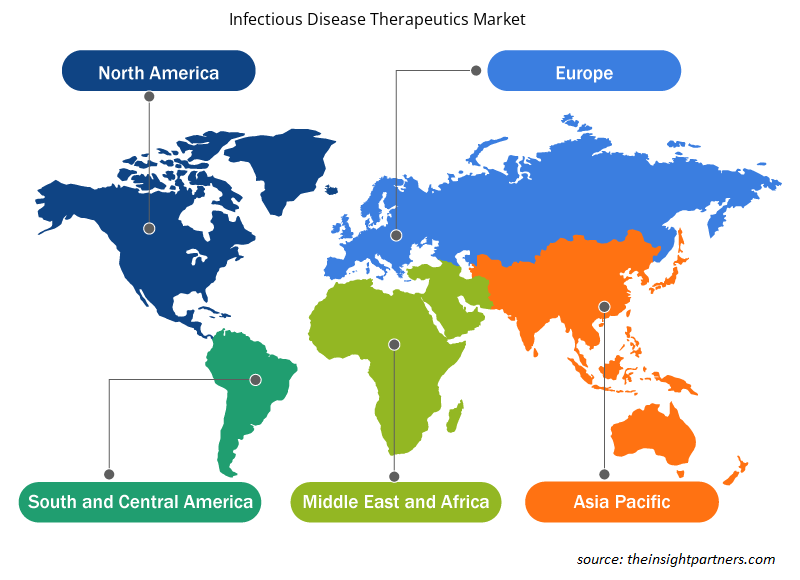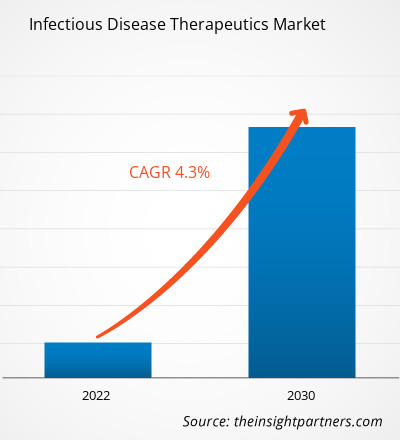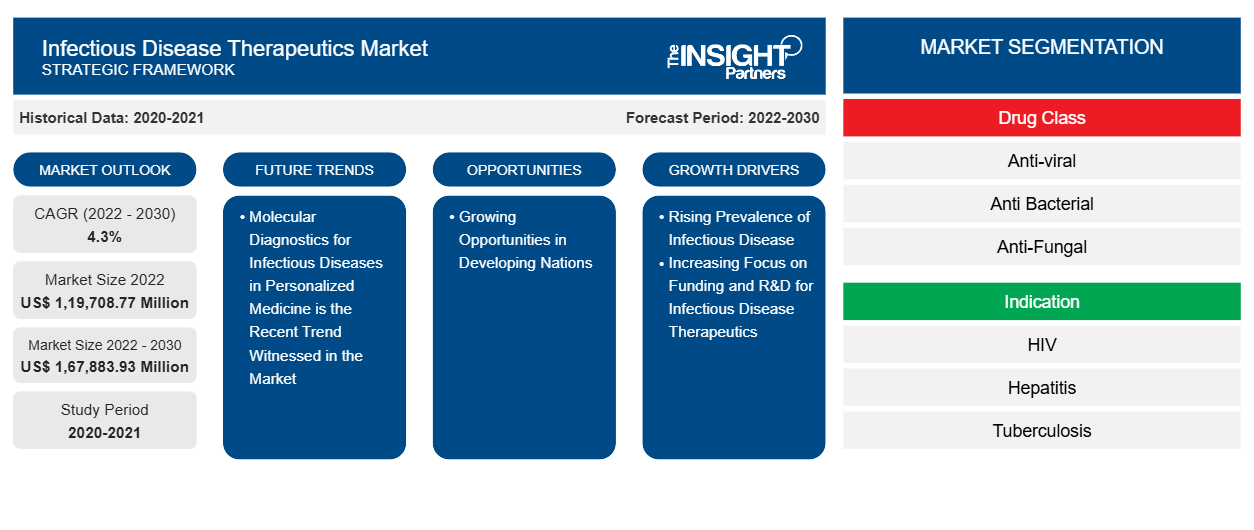El tamaño del mercado de terapias para enfermedades infecciosas en 2022 fue de 1.19.708,77 millones de dólares estadounidenses y se prevé que alcance los 1.67.883,93 millones de dólares estadounidenses en 2030. Se espera que el mercado registre una CAGR del 4,30 % durante 2022-2030. Es probable que el aumento del número de aprobaciones y lanzamientos de productos siga siendo una tendencia clave en el mercado.
Análisis del mercado de terapias para enfermedades infecciosas
La creciente prevalencia de enfermedades infecciosas en la sociedad, los actores del mercado han lanzado medicamentos avanzados para el tratamiento de trastornos infecciosos, las iniciativas tomadas por el gobierno para proporcionar a las personas instalaciones sofisticadas para el tratamiento de enfermedades infecciosas están impulsando el mercado.
Descripción general del mercado de terapias para enfermedades infecciosas
Las bacterias, los virus, los hongos y los parásitos son criaturas que causan enfermedades infecciosas. Los antibióticos, los antivirales y los antiparasitarios son algunos de los medicamentos que se utilizan para tratar los trastornos infecciosos. Los tratamientos para las enfermedades infecciosas pueden actuar directamente sobre los organismos o ayudar al sistema inmunológico del cuerpo a combatir las infecciones. Las enfermedades infecciosas incluyen el VIH, la tuberculosis, la malaria , la hepatitis y la gripe, entre otras.
Personalice este informe según sus necesidades
Obtendrá personalización en cualquier informe, sin cargo, incluidas partes de este informe o análisis a nivel de país, paquete de datos de Excel, así como también grandes ofertas y descuentos para empresas emergentes y universidades.
-
Obtenga las principales tendencias clave del mercado de este informe.Esta muestra GRATUITA incluirá análisis de datos, desde tendencias del mercado hasta estimaciones y pronósticos.
Factores impulsores y oportunidades del mercado de terapias para enfermedades infecciosas
El aumento de la atención a la financiación y la I+D en terapias para enfermedades infecciosas favorecerá el crecimiento del mercado
La investigación y el desarrollo (I+D) son una parte importante del negocio de las empresas farmacéuticas y biofarmacéuticas. La I+D permite a las empresas lanzar nuevos productos para diversas aplicaciones terapéuticas con un potencial médico y comercial significativo. Además, los principales actores del mercado están invirtiendo en I+D para desarrollar tecnologías mejoradas y obtener una mayor participación en los ingresos.
La siguiente tabla muestra la financiación anual para diversas categorías de enfermedades e investigaciones sobre la base de contratos, subvenciones y otros mecanismos de financiación utilizados en los Institutos Nacionales de Salud (NIH).
Enfermedades y financiación
Enfermedades/Áreas de investigación |
2019 (millones de dólares estadounidenses) |
2020 (millones de dólares estadounidenses) |
2021 (millones de dólares estadounidenses) |
2022 (millones de dólares estadounidenses) |
|
Enfermedades infecciosas emergentes |
2.950 |
4.867 |
5,069 |
4.318 |
|
Enfermedades infecciosas |
6.313 |
8.301 |
8,599 |
8,019 |
|
Infecciones de transmisión sexual |
354 |
394 |
404 |
419 |
Nota: Se considera el tipo de conversión actual para las monedas.
Fuente: Informes anuales y análisis de The Insight Partners
Los principales proyectos que han financiado los fabricantes:
• En junio de 2022, GSK plc invirtió 1210 millones de dólares (1000 millones de libras esterlinas) a lo largo de 10 años para acelerar la investigación y el desarrollo (I+D) centrados en enfermedades infecciosas que afectan desproporcionadamente a los países de bajos ingresos. La investigación se centrará en nuevos medicamentos y vacunas innovadoras para prevenir y tratar la malaria, la tuberculosis, el VIH (a través de ViiV Healthcare), las enfermedades tropicales desatendidas (ETD) y la resistencia a los antimicrobianos (RAM).
• En marzo de 2022, el Mecanismo de Respuesta a la COVID-19 del Fondo Mundial (C19RM) recibió una donación de 48,07 millones de dólares estadounidenses (60 millones de dólares canadienses) de Canadá, que fue elogiada por el Fondo Mundial de Lucha contra el SIDA, la Tuberculosis y la Malaria. Los nuevos fondos se utilizaron para ofrecer a los países de ingresos bajos y medios tratamientos vitales y pruebas de diagnóstico, incluido oxígeno médico y equipos de protección personal (EPP).
Por lo tanto, el creciente enfoque en la I+D y la financiación está impulsando el crecimiento del mercado de terapias para enfermedades infecciosas.
Oportunidades crecientes en los países en desarrollo
Se prevé que la creciente prevalencia de enfermedades infecciosas mejore las ventas de medicamentos para su tratamiento en los países emergentes. Debido a los menores requisitos de datos y a las leyes más estrictas, Asia Pacífico ha surgido como una región flexible y favorable para las empresas. Además, las grandes inversiones en investigación sanitaria y ciencias de la vida en los países emergentes desempeñan un papel importante en el apoyo a la tecnología de vanguardia en los países en desarrollo, lo que a su vez fomenta la tendencia hacia la detección y el tratamiento de las enfermedades infecciosas. Por ejemplo, ONUSIDA está pidiendo una inversión de 29.000 millones de dólares para 2025 para satisfacer las necesidades de prevención y tratamiento del SIDA de los países de ingresos bajos y medios. En la India, Corea del Sur, Brasil y México, las enfermedades infecciosas como la hepatitis, las infecciones asociadas a la atención sanitaria, el VIH y la gripe son prevalentes; hay una gran población de pacientes; el dinero disponible ha aumentado; la infraestructura sanitaria ha mejorado y el turismo médico está en expansión. Por lo tanto, los productores de productos terapéuticos esenciales para enfermedades infecciosas que están expandiendo sus mercados en estas naciones deberían esperar perspectivas rentables en el futuro.
Análisis de segmentación del informe de mercado de terapias para enfermedades infecciosas
Los segmentos clave que contribuyeron a la derivación del análisis del mercado de terapias para enfermedades infecciosas son la clase de medicamento, la indicación, la vía de administración y el canal de distribución.
- Según la clase de fármaco, el mercado de terapias para enfermedades infecciosas se divide en antivirales, antibacterianos, antifúngicos y otros. El segmento antiviral tuvo la mayor participación de mercado en 2022.
- Según los datos, el mercado está segmentado en VIH, hepatitis, tuberculosis, influenza, VPH y otros. El segmento del VIH tuvo la mayor participación del mercado en 2022.
- En términos de vía de administración, el mercado está segmentado en oral, parenteral, tópica y otras. El segmento de fabricantes orales tuvo la mayor participación del mercado en 2022.
- Según el canal de distribución, el mercado de terapias para enfermedades infecciosas se divide en farmacias hospitalarias, farmacias minoristas y otras. El segmento de farmacias hospitalarias tuvo la mayor participación de mercado en 2022.
Análisis de la cuota de mercado de los tratamientos para enfermedades infecciosas por geografía
El alcance geográfico del informe del mercado de terapias para enfermedades infecciosas se divide principalmente en cinco regiones: América del Norte, Asia Pacífico, Europa, Medio Oriente y África, y América del Sur y Central.
América del Norte ha dominado el mercado. Se prevé que la creciente adopción de avances tecnológicos y el aumento de las actividades de investigación y desarrollo aceleren el crecimiento del mercado de terapias para enfermedades infecciosas. Además, las grandes empresas de atención médica y la creciente demanda de soluciones terapéuticas avanzadas para tratar enfermedades crónicas y virales están impulsando la expansión del mercado en esta región.
Perspectivas regionales del mercado de terapias para enfermedades infecciosas
Los analistas de Insight Partners explicaron en detalle las tendencias y los factores regionales que influyen en el mercado de terapias para enfermedades infecciosas durante el período de pronóstico. Esta sección también analiza los segmentos y la geografía del mercado de terapias para enfermedades infecciosas en América del Norte, Europa, Asia Pacífico, Oriente Medio y África, y América del Sur y Central.

- Obtenga datos regionales específicos para el mercado de terapias para enfermedades infecciosas
Alcance del informe sobre el mercado de terapias para enfermedades infecciosas
| Atributo del informe | Detalles |
|---|---|
| Tamaño del mercado en 2022 | US$ 1,19,708.77 Millones |
| Tamaño del mercado en 2030 | US$ 1,67,883.93 Millones |
| CAGR global (2022-2030) | 4,3% |
| Datos históricos | 2020-2021 |
| Período de pronóstico | 2022-2030 |
| Segmentos cubiertos |
Por clase de fármaco
|
| Regiones y países cubiertos |
América del norte
|
| Líderes del mercado y perfiles de empresas clave |
|
Densidad de actores del mercado de terapias para enfermedades infecciosas: comprensión de su impacto en la dinámica empresarial
El mercado de productos terapéuticos para enfermedades infecciosas está creciendo rápidamente, impulsado por la creciente demanda de los usuarios finales debido a factores como la evolución de las preferencias de los consumidores, los avances tecnológicos y una mayor conciencia de los beneficios del producto. A medida que aumenta la demanda, las empresas amplían sus ofertas, innovan para satisfacer las necesidades de los consumidores y aprovechan las tendencias emergentes, lo que impulsa aún más el crecimiento del mercado.
La densidad de actores del mercado se refiere a la distribución de las empresas o firmas que operan dentro de un mercado o industria en particular. Indica cuántos competidores (actores del mercado) están presentes en un espacio de mercado determinado en relación con su tamaño o valor total de mercado.
Las principales empresas que operan en el mercado de terapias para enfermedades infecciosas son:
- Pfizer Inc
- Ciencias Gilead Inc.
- F. Hoffmann-La Roche Ltd
- Shionogi & Co Ltd
- Bayer AG
- Productos farmacéuticos BioCryst Inc.
Descargo de responsabilidad : Las empresas enumeradas anteriormente no están clasificadas en ningún orden particular.

- Obtenga una descripción general de los principales actores clave del mercado de terapias para enfermedades infecciosas
Noticias y desarrollos recientes del mercado de terapias para enfermedades infecciosas
El mercado de terapias para enfermedades infecciosas se evalúa mediante la recopilación de datos cualitativos y cuantitativos posteriores a la investigación primaria y secundaria, que incluye publicaciones corporativas importantes, datos de asociaciones y bases de datos. A continuación, se enumeran algunos de los avances en el mercado de terapias para enfermedades infecciosas:
- Roche lanzó las primeras pruebas de enfermedades infecciosas y el canal de utilidades omni cobas para su uso en el sistema cobas 5800 en países que aceptan la marca CE. El canal de utilidades omni cobas en el sistema cobas 5800 permite un menú de pruebas más amplio al consolidar los ensayos de canal abierto con los ensayos de diagnóstico in vitro (IVD) de Roche en una única plataforma. (Fuente: F. Hoffmann-La Roche Ltd, comunicado de prensa, diciembre de 2022)
Informe sobre el mercado de terapias para enfermedades infecciosas: cobertura y resultados
El informe “Tamaño y pronóstico del mercado de terapias para enfermedades infecciosas (2020-2030)” proporciona un análisis detallado del mercado que cubre las siguientes áreas:
- Tamaño del mercado de terapias para enfermedades infecciosas y pronóstico a nivel mundial, regional y nacional para todos los segmentos clave del mercado cubiertos bajo el alcance
- Tendencias del mercado de terapias para enfermedades infecciosas, así como dinámicas del mercado, como impulsores, restricciones y oportunidades clave
- Análisis detallado de las cinco fuerzas de Porter y PEST y FODA
- Análisis del mercado de terapias para enfermedades infecciosas que abarca las tendencias clave del mercado, el marco global y regional, los principales actores, las regulaciones y los desarrollos recientes del mercado.
- Análisis del panorama de la industria y de la competencia que abarca la concentración del mercado, el análisis de mapas de calor, los actores destacados y los desarrollos recientes del mercado de terapias para enfermedades infecciosas
- Perfiles detallados de empresas
- Análisis histórico (2 años), año base, pronóstico (7 años) con CAGR
- Análisis PEST y FODA
- Tamaño del mercado, valor/volumen: global, regional y nacional
- Industria y panorama competitivo
- Conjunto de datos de Excel
Informes recientes
Testimonios
Razón para comprar
- Toma de decisiones informada
- Comprensión de la dinámica del mercado
- Análisis competitivo
- Información sobre clientes
- Pronósticos del mercado
- Mitigación de riesgos
- Planificación estratégica
- Justificación de la inversión
- Identificación de mercados emergentes
- Mejora de las estrategias de marketing
- Impulso de la eficiencia operativa
- Alineación con las tendencias regulatorias























 Obtenga una muestra gratuita para - Mercado de terapias para enfermedades infecciosas
Obtenga una muestra gratuita para - Mercado de terapias para enfermedades infecciosas